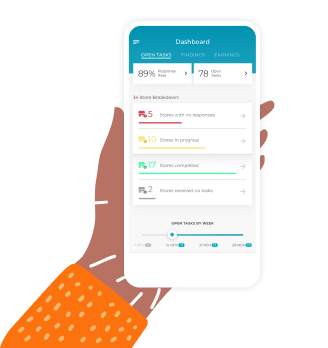The performance of your retail business largely depends on your staff. Yes, great systems and technologies are essential, but it’s the people who work in your store who will ultimately connect with your customers and drive sales.
That’s why it’s not enough to hire the right individuals; you also need to train them properly. While it’s tempting to get new hires up and running as quickly as possible, the best course of action is often to take your time with onboarding your team members. You should arm your associates with the right tools and empower them with the knowledge and skills they need to shine on the sales floor.
Let’s look at some of the ways you can boost your store training initiatives.
Adopt a 24/7 Hiring Mindset
It takes retailers an average of 24.6 days to hire a new employee, which means that if there’s a hole in your team, you’re looking at nearly a month of being short-staffed. This can be problematic particularly when you’re running a busy retail store. When it’s crunch time, managers end up hiring candidates who are available instead of being the very best.
You can prevent this by adopting a hiring mindset even when there’s no immediate need for new people. Pay attention to hiring trends and keep your eyes open to great talent at all times.
A 24/7 hiring mindset also manifests in how you promote your business in the job market. By positioning your company a great place to work even when you’re not actively hiring, you’ll put yourself on the radars of candidates and naturally attract great people.
Retailers such as Costco and Lululemon do an excellent job here. Both companies publicly tout the benefits they offer and they’ve invested in dedicated “Career” pages on their websites.
Strive to do something similar in your recruitment efforts. See to it that you and your team have a hiring mindset 24/7 and make your business more marketable to candidates.
That way, when the need to recruit new people does arise, you’ll have a much better pool of candidates to choose from.
Prepare Your Team for Everyday Situations and Unexpected Scenarios
Train your team for both the expected AND unexpected. The former helps them adjust to your store’s environment and day-to-day activities much quicker, while the latter ensures that your staff can handle not-so-everyday occurrences.
Below are some pointers on how to accomplish this.
Document all your processes and workflows. This is one of the most important components of any store training program. Put all your retail processes on paper and make that document accessible to all your employees. Have new hires read and understand the document during onboarding, but also make sure they can refer to it on the job. You can easily do this using a shared online document or knowledge base.
Some of the things you should document are:
- Customer service (e.g., how to greet shoppers, what to say or not to say)
- Inventory management (e.g., stock counts, placing orders.)
- Working the register (e.g., ringing up sales, using the POS system)
- Safety and security measures (e.g., how to avoid safety hazards, what to do in emergency situations)
Share common customer concerns and sales objections. In addition to teaching your staff about your systems and processes, you should also train them on how to relate better to your customers.
Have a list of common lines and objections that you get from shoppers, and educate your team on what to say and what not to say. Doing so gives them the confidence to take on any situation — unexpected or otherwise.
If you’re looking for a retail role model for this pointer, look no further than Apple. The tech retailer has a thorough “Genius Training” manual that covers everything from sales and customer service to psychology and Apple culture.
For instance, the manual has an entire section dedicated to “Empathy Exercises” which offers pointers and examples of how Geniuses can relate to customers in a more powerful way that resonates. The document also covers verbal and non-verbal cues to help employees navigate tricky customer interactions and ensure that they handle things the Apple way.
Aim for that level of detail when crafting your store training documents. Spend time thinking about various scenarios that happen in your stores and write down the best course of action for each situation.
Give Established Team Members a Role in Hiring and Onboarding
The success of your team is… well, a team effort, which is why it’s important to rope in your established workforce when hiring and onboarding new employees. Your seasoned workers can enhance your store training processes in two ways:
They can train new hires efficiently. Pair up your newbies with established team members to get the new hires on board much quicker. Your more experienced employees can show them the ropes and offer guidance on everything from running the store to dealing with customers.
They can quickly identify who isn’t a great fit. Your seasoned team members are in a great position to determine the best people for the job. Have them observe your new hires as they go about the hiring and training process, then ask for their input on who’s working and who isn’t.
Leverage Technology
Don’t underestimate the role of technology in the hiring and store training stages. When used correctly, tools such as e-learning platforms, mobile tech, and even artificial intelligence and machine learning can streamline how you get people onboard their new roles.
Retailers like Phillips-Van Heusen, for example, are using online training portals to onboard fresh hires. This saves time and allows the company to get people up to speed more efficiently.
And with technologies like AI and ML, you can create personalized, trigger-based learning experiences and tailor your onboarding programs to each new hire’s (or your organization’s) most immediate needs.
Utilize Various Training Techniques
Speaking of personalized employee experiences, you should also recognize that your staff members have different learning styles and preferences. While some people thrive in group settings, others prefer consuming educational materials on their own.
For this reason, it’s important to utilize multiple techniques and materials when training new employees. For instance, if you’re educating your team on how to use your inventory management system, it’s a good idea to convey information in various ways, including a software manual, video tutorial, and hands-on session.
Or if you’re training people on how to deal with customers, then you’ll want to combine text and verbal training with role-playing.
Doing so not only covers multiple learning styles, it also improves comprehension, as knowledge tends to “stick” better when people experience a lesson in different ways.
Get New Hires Pumped About the Company and Their Jobs
While strategies and techniques are important to an employee’s success, remember that enthusiasm also plays a significant part in their performance.
So, find ways to get your team excited about coming to work. Motivate them with an inspiring story about your brand. Give them access to exclusive perks like free samples and discounts. Make sure they know that there’s room for growth and development. While many retailers do this anecdotally, the best work it in to their formal store training practice.
The “right” employee motivation tactic varies from one retailer to the next. You have to discover what lights up your employees and find a way to cultivate their enthusiasm.
The Bottom Line: Never Overlook Store Training
It’s easy for hiring and onboarding to be an afterthought when you have a busy store to run and just want to get things done. But cutting corners on these things leads to weak hires, high turnover, and ultimately poor customer experiences.
So, do yourself — and your team — a favor and invest in the hiring and onboarding your team properly.
Learn how CB4 helps store managers and their teams identify and resolve urgent floor execution issues in their stores that damage the customer experience and hurt sales.

